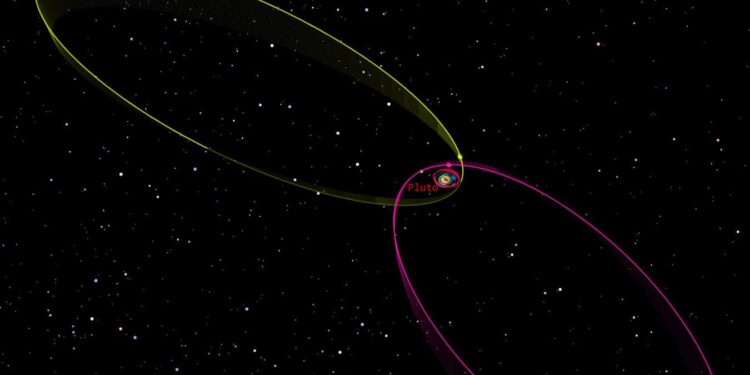
The orbits of a potential dwarf planet called 2017 OF201 and the dwarf planet Sedna
Tony Dunn
A potential dwarf planet has been discovered in the outer reaches of our solar system, orbiting beyond Neptune. Its presence there challenges the existence of a hypothetical body known as Planet 9 or Planet X.
Sihao Cheng at the Institute for Advanced Study in Princeton, New Jersey, and his colleagues first detected the object, known as 2017 OF201, as a bright spot in an astronomical image database from the Victor M. Blanco Telescope in Chile.
2017 OF201 is about 700 kilometres across – big enough to qualify as a dwarf planet like Pluto, which has a diameter about three times as big. The object is currently about 90.5 astronomical units (AU) away from us, or roughly 90 times as far from Earth as the sun is.
Because 2017 OF201’s average orbit around the sun is greater than that of Neptune, it is what’s known as a trans-Neptunian object (TNO). It passes through the Kuiper belt, a disc of icy objects in the outer solar system beyond the orbit of Neptune.
The researchers looked back over 19 observations, taken over seven years by the Canada France Hawaii Telescope, to determine that the closest 2017 OF201 gets to the sun – its perihelion – is 44.5 AU, which is similar to Pluto’s orbit. The furthest it gets from the sun is 1600 AU, way outside the solar system.
This far-flung orbit may be the result of an encounter with a giant planet, which ejected the candidate dwarf planet out of the solar system, say the researchers.
“It’s a really cool discovery,” says Kevin Napier at the University of Michigan. The object would go so far outside the solar system that it could be interacting with other stars in the galaxy just as strongly as it interacts with some of the planets in our solar system, he says.
The orbits of many extreme TNOs seem to cluster in a specific orientation. This has been interpreted as evidence that the solar system contains a ninth planet hidden in the Oort cloud, a vast cloud of icy rocks encircling the solar system. The idea is that Planet 9’s gravity pushes the TNOs into their specific orbits.
But the orbit of 2017 OF201 doesn’t fit this pattern. “This object is definitely an outlier to the observed clustering,” says team member Eritas Yang at Princeton University.
Cheng and his colleagues also modelled simulations of the object’s orbit, and how it might interact with Planet 9. “In the one with Planet X, the object gets ejected after a couple of hundred million years, and without Planet X, it stays,” says Napier. “Certainly, this is not evidence in favour of Planet 9.”
But until there is more data, the case isn’t closed, says Cheng. “I hope Planet 9 still exists, because that’ll be more interesting.”
The candidate dwarf planet takes roughly 25,000 years to complete an orbit, which means it spends only about 1 per cent of its time close enough to Earth for us to detect it. “These things are really hard to find because they’re faint, and their orbits are so long and skinny that you can only see them when they’re really close to the sun, and then they immediately head right back out and they’re invisible to us again,” says Napier.
That means there might be hundreds of such objects out there. The Vera C. Rubin Observatory, due to go online later this year, will look deeper into space and will potentially detect many more objects like this, which should tell us more about them – and whether Planet 9 actually exists.
Topics:
Source link : https://www.newscientist.com/article/2481477-new-dwarf-planet-spotted-at-the-edge-of-the-solar-system/?utm_campaign=RSS%7CNSNS&utm_source=NSNS&utm_medium=RSS&utm_content=home
Author :
Publish date : 2025-05-22 20:00:00
Copyright for syndicated content belongs to the linked Source.














